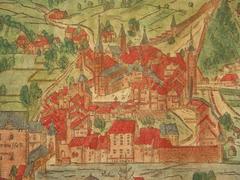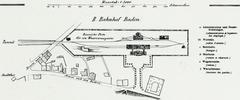
Stein Castle Baden Switzerland: Visiting Hours, Tickets, and Historical Sites Guide
Date: 04/07/2025
Introduction
Stein Castle—known locally as Ruine Stein—is a striking medieval ruin that crowns the Schlossberg hill, offering commanding views over the historic town of Baden in Switzerland’s Aargau canton. With origins in the 11th century, this castle was built by the Counts of Lenzburg and later controlled by the Kyburg and Habsburg dynasties. Throughout its storied history, Stein Castle has played a pivotal role in regional politics, witnessed dramatic conflicts, and left an indelible mark on Baden’s cultural landscape.
Today, the ruins—featuring a robust main tower, the preserved St. Niklaus chapel, a watchtower, and remnants of city walls—invite visitors to explore Switzerland’s medieval heritage free of charge. This comprehensive guide details Stein Castle’s history, architectural highlights, visiting hours, accessibility, travel tips, and nearby attractions, ensuring you make the most of your visit to one of Baden’s most iconic landmarks.
For up-to-date information, consult the Dein Baden and MySwitzerland websites.
Table of Contents
- Introduction
- Early Origins and Construction
- Dynastic Transitions and Historical Role
- The 1415 Conquest and its Aftermath
- Surviving Structures and Preservation
- Architectural and Archaeological Features
- Visiting Hours, Tickets, and Accessibility
- Getting There: Directions and Transport
- Nearby Attractions and Visitor Tips
- Events and Seasonal Highlights
- Safety and Practical Advice
- Frequently Asked Questions (FAQ)
- Conclusion and Travel Resources
- Sources
Early Origins and Construction
Built in the 11th century by the Counts of Lenzburg, Stein Castle strategically overlooks the Limmat River and the emerging settlement of Baden. Its hilltop position provided natural defense and clear lines of sight across the valley, making it a formidable stronghold. The original castle likely comprised a sturdy residential tower (Wohnturm), a great hall (palas), a triangular courtyard, and a chapel, all constructed from locally sourced stone. These features exemplify the robust design of high medieval Swiss fortifications (deinbaden.ch, myswitzerland.com).
Dynastic Transitions and Historical Role
With the extinction of the Lenzburg line, the castle passed to the Counts of Kyburg and, after 1263, to the Habsburgs. Under Habsburg rule, Stein Castle became an administrative center for their Swiss territories and a symbol of their regional authority. The Habsburgs expanded the castle, reinforcing its defensive structures and integrating it into Baden’s city fortifications. Stein Castle’s prominence mirrored Baden’s growth as a regional hub on key trade routes between Zurich and Basel (deinbaden.ch).
The 1415 Conquest and its Aftermath
In 1415, the Old Swiss Confederacy conquered the Aargau region, capturing and purposefully destroying Stein Castle to thwart its future military use. Over the following centuries, the ruins were adapted for new purposes, and after the Second Battle of Villmergen in 1712, much of the remaining structure was demolished. Notably, stones from the castle were reused to construct the Reformed church near Baden’s Bahnhofplatz, reflecting the era’s religious and political transformations (myswitzerland.com).
Surviving Structures and Preservation
Despite centuries of conflict and demolition, visitors today can explore the surviving main tower, St. Niklaus chapel, watchtower, and sections of the city walls. Modern preservation efforts have stabilized the ruins, installed safety railings, and provided interpretive signage to enhance visitor safety and understanding (deinbaden.ch).
Architectural and Archaeological Features
Site Layout and Highlights
- Main Tower (Keep): The castle’s most prominent surviving structure, dating to the 12th century, with thick Romanesque stone walls (explorial.com).
- St. Niklaus Chapel: A fully preserved medieval chapel adjacent to the main tower, offering insight into the castle’s spiritual life (kinderregion.ch).
- Watchtower and Courtyard: Foundations of the triangular courtyard and flanking watchtower are visible; these structures were crucial for surveillance and defense (deinbaden.ch).
- Outer Walls and City Defenses: Fragments of the curtain walls illustrate the integration of the castle’s defenses with those of Baden.
- Gunpowder Cellar: A vaulted chamber once used for munitions storage, reflecting the site’s military adaptations (kinderregion.ch).
Archaeological Discoveries
Excavations have uncovered foundations from the original 10th–11th-century fortifications, later expansions by the Kyburgs and Habsburgs, and artifacts such as ceramics and metalwork. Many finds are displayed at the Baden History Museum (audiala.com, wikipedia).
Architectural Evolution
- Lenzburg and Kyburg Expansion: Early construction followed by residential and defensive additions.
- Habsburg Period: Enlargement and reinforcement, reflecting the castle’s administrative role (spottinghistory.com).
- Destruction and Reuse: Repeated damage and rebuilding, culminating in partial demolition and stone repurposing (myswitzerland.com).
- Conservation: Recent efforts focus on stabilization, visitor safety, and educational signage (explorial.com).
Visiting Hours, Tickets, and Accessibility
- Visiting Hours: Stein Castle is open year-round, 24/7, with no restrictions on entry times (trek.zone).
- Tickets: Admission is free.
- Facilities: No on-site restrooms; public toilets are available in Baden’s old town.
- Accessibility: Access involves steep stone staircases; the site is not suitable for wheelchairs or strollers. Sturdy footwear is strongly advised.
Getting There: Directions and Transport
By Public Transport
- Train: Baden is about 20 minutes from Zurich by direct train (switzerlanding.com).
- On Foot: From Baden train station, walk toward the old town, pass through the Stadtturm, and ascend the stone staircases on the right.
By Car
- Accessible via the A1 motorway. Parking is available at Trafo, Gstühl, and Theatreplatz car parks. From there, a short walk leads to the castle.
Nearby Attractions and Visitor Tips
- Stadtturm (City Tower): Iconic 15th-century gate, a 4-minute walk from the castle.
- Landvogteischloss (Bailiff’s Castle): Now the Historical Museum Baden, 7 minutes away.
- Covered Wooden Bridge: Picturesque bridge across the Limmat, a 7-minute walk.
- Thermal Baths: World-famous spa facilities are nearby, including FORTYSEVEN wellness spa (myswitzerland.com).
- Dining: The old town offers numerous restaurants and cafés, with Restaurant Belvédère a favorite for Swiss cuisine and views.
Events and Seasonal Highlights
- Saturday Markets: Local produce and artisan stalls line the Weitergasse.
- Christmas Market: The old town hosts a festive market in winter.
- Guided Tours: The Baden tourist office offers occasional themed tours that include Stein Castle (myswitzerland.com).
Safety and Practical Advice
- Weather: The site is exposed; bring sun protection or rain gear as needed.
- Children: Supervise young children due to uneven surfaces and steep drops.
- Best Times: Early morning or late afternoon for optimal light and fewer visitors.
- Picnics: Benches and open spaces are suitable for informal picnics.
Frequently Asked Questions (FAQ)
Q: Do I need a ticket to visit Stein Castle?
A: No, entry is free and unrestricted.
Q: What are the castle’s opening hours?
A: The ruins are accessible at all times, year-round.
Q: Is Stein Castle accessible for wheelchairs?
A: No, access involves steep stone staircases.
Q: Are guided tours available?
A: Occasionally, through the Baden tourist office.
Q: What else is there to see nearby?
A: Stadtturm, Bailiff’s Castle, covered wooden bridge, and Baden’s museums.
Conclusion and Travel Resources
Stein Castle is a highlight of Baden’s historic landscape, encapsulating Switzerland’s medieval legacy and providing breathtaking views across the Limmat Valley. Its ruins, rich history, and integration with the town’s broader cultural offerings make it an essential stop for visitors. Whether you are drawn by architecture, photography, or Baden’s vibrant festivals, a visit to Stein Castle promises a memorable and enriching experience.
For additional information, guided tour bookings, and updates on special events, consult the following resources:
Download the Audiala app for audio guides and travel tips, and follow us on social media for news and inspiration.
Sources
- Stein Castle: A Comprehensive Guide to History, Visiting Hours, and Attractions in Baden, 2025, Dein Baden
- Architectural and Archaeological Features, 2025, MySwitzerland & Explorial
- Stein Castle Visiting Hours, Tickets & Historical Guide to Baden’s Medieval Landmark, 2025, Studying in Switzerland
- Complete Guide to Stein Castle Visiting Hours, Tickets, and Baden’s Historic Attractions, 2025, Switzerlanding & Trek.Zone, https://trek.zone/en/switzerland/places/70594/stein-castle-baden



